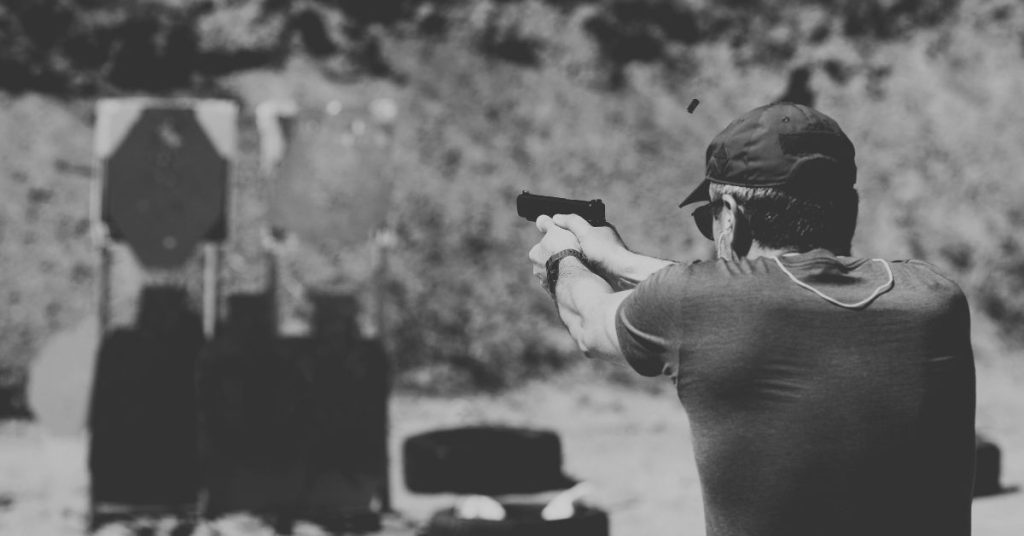Range training is an important tool for people learning to shoot and those who want to hone their skills. Shooting ranges come in all shapes and sizes, including indoor and outdoor.
Most are privately owned, although there are those operated by military or law enforcement agencies. Each facility has one or more professional shooters/instructors onsite.
The personnel are present to oversee operations and ensure the use of all safety precautions.
Indoor ranges are found most often in urban or heavily populated areas. The containment of the range prevents collateral damage, noise, and environmental concerns.
They are also ideal despite weather conditions. Note: indoor ranges often restrict the type of weapon/caliber being used onsite.
Outdoor ranges are preferred by hunters since the conditions mirror what they would face in the field. Competitions are generally held at outdoor ranges.
Development of .223 Remington Ammo
The 1950s changed the firearms industry in many ways. The American military started to demand lightweight rifles. In 1955, ArmaLite’s Chief Engineer, Eugene Stoner, presented his design for the ArmaLite AR-10.
The AR-10 was the first lightweight infantry rifle, chambered to the 7.62x51mm NATO. The military rejected the AR-10 in favor of the M14, probably because the former was too late to complete the appropriate tests.
The military revived the AR-10’s hopes in 1957. The United States Continental Army Command asked for a smaller version of the gun. They wanted the new rifle to use .22 caliber ammo. Stoner invented the AR-15 rifle.
In 1964, the U.S. Air Force adopted the AR-15 as the M-16 rifle. The M-16 eventually became the standard issue rifle for the military.
In 1980, .223 Remington ammo was changed again. It now uses a 62-grain full metal jacket bullet with a 7-grain steel core for improved penetration.
Current Specifications
The standard .223 cartridge uses a .224-inch diameter boat-tailed bullet in a rimless, bottle-necked case. The bullet measures 1.76 inches in length with the overall length of the round is 2.26 inches.
Standard factory loads range in weight from 35 to 85 grains. However, the most common is the 55-grain bullet. It has a max pressure of 55,000 PSI.
Popular Use
Remington introduced .223 ammo to the public one month before it was adopted by the Air Force. It uses a lower pressure than the 5.56 NATO. As a result, it is good for target shooting, plinking and for novices.
Although it isn’t legal in all states, shooters often use the ammo to hunt deer or similar medium-size game. Perhaps the most common use is to control varmints – rats, rabbits, gophers, weasels, groundhogs, etc.
The round can also stop larger pests such as foxes, skunks, feral dogs and cats, coyotes, raccoons, and opossums. The ammunition is cheap, especially if it’s purchased in bulk. Secondly, it’s easy to get and can be used for a variety of things.
In addition to general use, .223 ammo is also a preferred round for law enforcement agencies. Police often use the ammo in their patrol cars, often as a replacement for a 12-gauge shotgun if they require more accuracy and precision.
.223 at the Range
Shooters like to use .223 ammo during target shooting and range training for several reasons. The 55-grain bullet is lightweight so there is little recoil.
The round is economical, reloadable, and a good choice for novice shooters or those that burn through hundreds of rounds at one time. When it comes to AR ammo, .223 is a popular choice along with the 5.56 NATO.
Important Differences in AR Ammo
One of the most important things to know right out of the gate is that there are two types of AR-15 ammo – the 5.56 NATO cartridge and .223 Remington ammo. Selecting the right ammo is dependent upon the type of chamber in your rifle.
For example, if your rifle is manufactured to chamber the .223 Remington, then that is the ammo you must use. If the rifle is chambered for the 5.56 NATO, then your rifle will accept both types of ammo.
While the size is the same, the 5.56 NATO has higher pressure, something that a rifle chambered solely for the .223 can’t safely handle.
Both rounds are excellent for range raining. The .223 is also preferred by varmint hunters and those seeking to rid their territory of predators.
It is effective against small vermin such as rodents and medium-sized predators like coyotes. It should be noted that the round is not suitable for large game hunting and is illegal in some jurisdictions.
Bullet Types
Full Metal Jacket (FMJ)
The Full Metal Jacket (FMJ) is the most common type of ammo because it’s easier to manufacture and less expensive than other rounds. Standard bullet weights of FMJ ammo in .223/5.56 are 55 and 62 grain.
Ammo with lighter grain bullets work best with higher barrel twist rate like 1:8 and 1:9. The lowest common twist rate is 1:7, which is commonly used with a 62 grain bullet.
Hollow Points (HP)
Hollow Point (HP) ammunition is most often related to personal and home defense. The cost of a hollow point is higher than an FMJ but is more effective for defense. The ballistics of a hollow point are similar to an FMJ, only lighter.
Soft Points (SP)
Soft Points (SP) are a popular hunting cartridge, but still popular for
AR-15 owners. The expansion of an SP is superior to an FMJ but has more control than the HP. The ballistics of SP ammo are excellent, particularly when paired with a boat-tail design.
Read more here to learn the differences between the hollow point and soft points.
Best .223 Range Training Ammo
The top two things to look for when choosing the best range training ammo is low price and accuracy. Each of these choices offers that plus smooth feeding, eliminating jams and failures. Our top choices include:
Wolf Ammunition: Performance Gold 55 Grain FMJ
Manufactured with brass casing and Boxer priming, this all-purpose round is affordable and reloadable.
Ballistics Info:
- 3,250 FPS Muzzle Velocity
- 1,290 ft-lbs Muzzle Energy
- 55 Grain
- FMJ Bullet
- Brass Casing
- Boxer Primer
Federal Ammunition: XM193 Tactical Rifle Ammunition 55 Grain FMJ-BT
Federal American Eagle NATO Tactical Rifle Ammunition is ideal for sports shooting and range training. This tactical-grade ammo uses high quality and promises excellent accuracy and reliability. The boat-tail design offers great aerodynamics.
Ballistics Info:
- 3,240 FPS Muzzle Velocity
- 55 Grain
- FMJ Boat-Tail
- Steel Casing
- Berdan Primer
Prvi Partizan Ammunition: 55 Grain Soft Point
Also reloadable, this round is affordable and available in bulk.
Ballistics Info:
- 3,248 FPS Muzzle Velocity
- 1,283 ft-lbs Muzzle Energy
- 55 Grain
- SP Bullet
- Brass Casing
- Boxer Primer
Tula Ammunition: 55 Grain FMJ
This .223 ammo is made using a steel casing and Berdan primer.
Ballistics Info:
- 3,241 FPS Muzzle Velocity
- 55 Grain
- FMJ Bullet
- Steel Casing
- Berdan Primer
Federal Ammunition: Fusion Bonded BT
Federal Fusion is one of the highest rated brands of varmint/game hunting ammunition. The reloadable rounds have a bonded core and offer high terminal performance down range.
The boat-tail design has excellent aerodynamics and allows for radiated shock upon impact.
Ballistics Info:
- 3,000 FPS Muzzle Velocity
- 1,239 Muzzle Energy
- 62 Grain
- FMJ Bullet
- Brass Casing
- Boxer Primer
Fiocchi Ammo: 55 Grain FMJ
Fiocchi is well-known for highly accurate, precision ammo. They use cleaning burning powder and Berdan primer. The Boat-tail design offers excellent aerodynamics and accuracy.
Ballistics Info:
- 3,240 FPS Muzzle Velocity
- 1,281 ft-lbs Muzzle Energy
- 55 Grain
- FMJ Boat-Tail
- Steel Casing
- Berdan Primer
Federal American Eagle Ammo: 55 Grain FMJ-BT
American Eagle is at the top of the list with their lightweight Full Metal Jacket Boat-Tail ammo. The rounds are accurate at various distances. This ammo is ideal for range training, competition, and plinking.
Ballistics Info:
- 3,240 FPS Muzzle Velocity
- 55 Grain
- FMJ Boat-Tail
- Brass Casing
- Boxer Primer
Federal Ammunition: Black Pack 223/5.56mm Ammo 55 Grain FMJ
Federal Black Pack 223/5.56mm Ammo 55 Grain ammunition offers the precision, reliability and accuracy customers have come to expect. This cartridge is a new production, re-loadable ammunition with boxer primers and brass casing.
Ballistics Info:
- 3,240 FPS Muzzle Velocity
- 55 Grain
- FMJ Bullet
- Brass Casing
- Boxer Primer
PMC Ammo: Bronze 55 Grain FMJ-BT
Precision Made Cartridges (PMC) is a South Korean manufacturer well-known for maintaining high manufacturing standards. The company makes all its components, ensuring that there is never a breakdown in quality.
Additionally, this affordable ammunition doesn’t skimp on quality. The boat-tail design gives high velocity and accuracy.
Ballistics Info:
- 3,200 FPS Muzzle Velocity
- 1,250 Muzzle Energy
- 55 Grain
- FMJ Boat-Tail
- Brass Casing
- Boxer Primer
Conclusion
The .223 Remington is a versatile, adaptable and versatile caliber. It comes in many types and weights, covering a wide range of applications.
This ammo is used for varmint control, small to medium game hunting, range training, target shooting and home and personal defense. Additionally, the ammo is accurate, cheap, easy to use and can be found even in times of a shortage.

